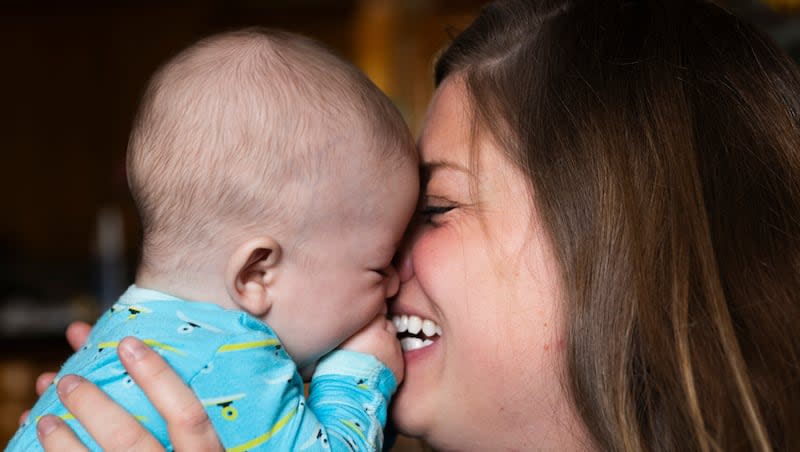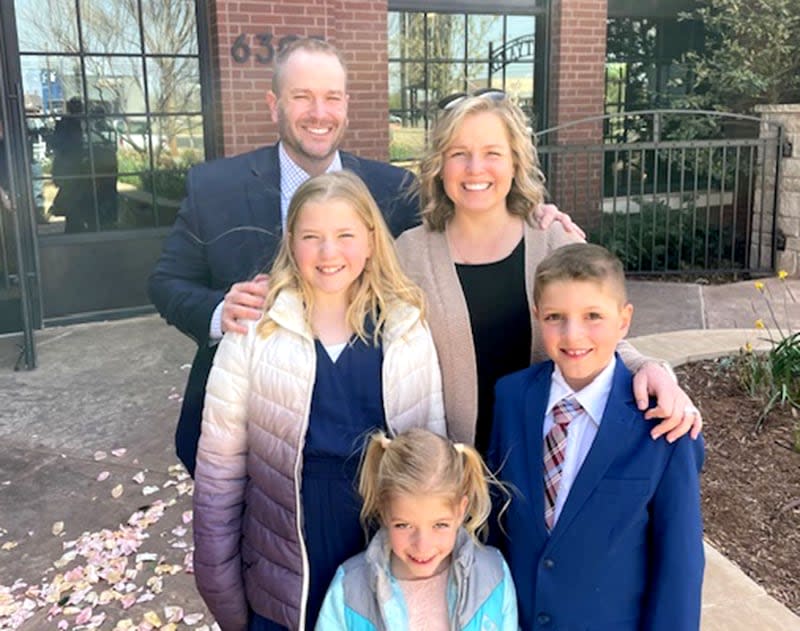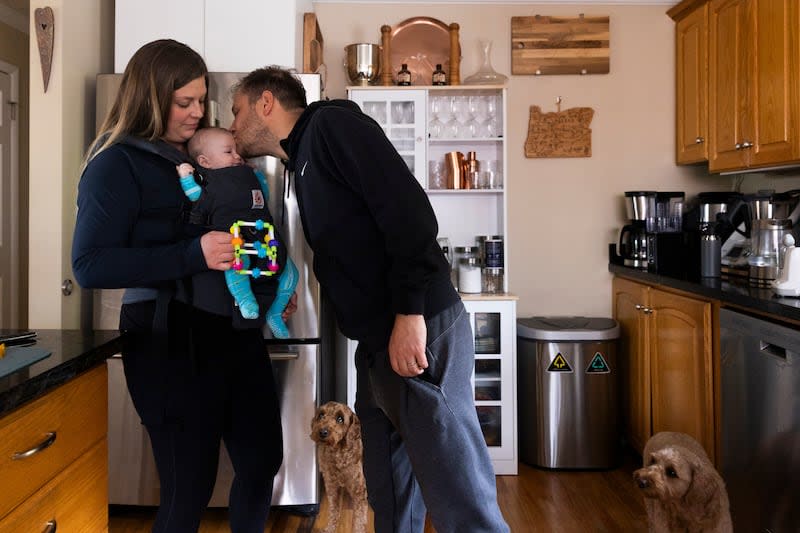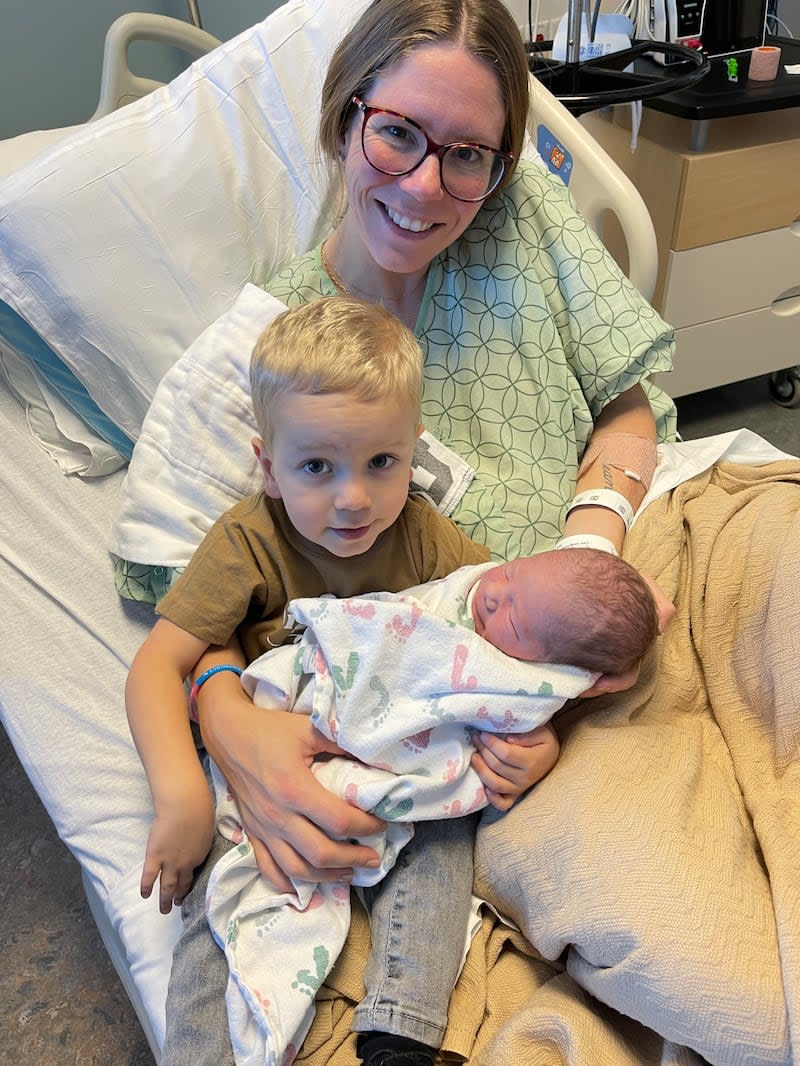Rainbow babies: Birth of a miracle after a loss

Nicole Atzeni gladly admits that she’s totally smitten with little Edo — short for Edoardo — who’s just 4 months old. So much so that she cried when she returned to work as a Salt Lake district school nurse. Being his mother has made her a happier, better person, she says.
The pregnancy itself, though, was terrifying, she adds. She’d learned that things can go terribly wrong when you’re building a family, and sometimes you won’t ever know why.
Her first child, who she and her husband Simone called simply Baby P because they hadn’t yet decided on a name, died during the second trimester of the pregnancy. Everything had seemed normal — until nothing did after that day in July 2021.
The Atzenis had hoped for two children. After Baby P died, she said she and her husband, who’s originally from Italy and is “my very best friend,” didn’t give up on being parents. But they were certainly scared.
Some people consider Edo a “rainbow baby,” a name given to children born after a pregnancy loss because they’re each a bit of beautiful magic after a stormy season of devastating sorrow.
Miscarriages — the spontaneous loss of pregnancy before the 20th week — are not uncommon. Even less common are stillbirths, which occur when a mother gives birth to a baby who dies in the womb or during labor at 20 weeks or later, but they still outnumber all the deaths of children ages 1-14. Worldwide, 2 million babies are stillborn every year at 28-plus weeks gestation.
The babies die because of obstetric complications, a placenta that fails, genetic or structural abnormalities, infection, problems with the umbilical cord, mom’s medical challenges, or hypertension, among other reasons, says Dr. Bob Silver, professor of obstetrics and gynecology at University of Utah Health Sciences Center and a maternal-fetal medicine specialist who is heading up the university’s new Utah Pregnancy After Loss Program, soon to be one of three Rainbow Clinic Network sites in the U.S.
The Utah program is having a ribbon-cutting for patients and media Monday, though Silver’s been helping moms who suffered pregnancy loss to have successful pregnancies for more than 35 years.
Factors that contribute to a miscarriage or stillbirth differ for individual women and their babies, if they’re ever even discovered. But some things are nearly universal, including that fear and sense of shock, that profound feeling of loss that Jaymie Maines will tell you never goes completely away.
“I don’t think you ever get over it. I think you grow around it. Grief is interesting. I think you learn how to deal with it. And it changes throughout the years, the different amounts that you feel it. You learn how to live with it.”
When Maines, of Riverton, went into labor, she and her husband Mark headed for the hospital. It was in a hospital triage room, where they thought she was being prepared to welcome her son, that an on-call doctor said Baby James died in the womb. She’d been pregnant 39 weeks. James was beautiful, a perfect 6-pound, 6-ounce baby when they lost him 14 years ago. They never learned why.
She still had to deliver him. Then, devastated, she and Mark held him for nine hours, unwilling to let go. They took photographs to have a tangible reminder that he was real and he was loved. “At the time, I felt so broken, like a deflated balloon,” she says now. “I was the only mom crying in that delivery room.”
Later, they would decide they wanted to try again, though Maines, like Atzeni, describes being scared the entire pregnancy.
Not long after James died, she had a miscarriage, which is more common after a pregnancy loss. The Maines have since had three more children: Haylee, 13; McCoy, 10; and Madyson, 7, with Silver’s specialized help and attention.
“Three babies and an angel,” she tells Deseret News. The Maines visit his grave — and never miss Christmas, which they make a joyful occasion. “James is buried in my mom’s cemetery plot in Sandy. She says when the time comes, she’ll hold him ‘til I get there.”

A multilayered loss
Pregnancy after loss requires a different kind of care, Silver says, and that’s what the new clinic — and the entire network, started by Professor Alex Heazell at University of Manchester in the U.K., is designed to deliver.
The program has three focuses: pregnancy health, mental health and peer support. It also has a strong research component. Silver and his colleagues want to learn everything they can so that pregnancy loss becomes less common everywhere.
“It’s not dramatically different from other clinics,” Silver said, but aspects set it apart. Providers spend more time with patients. When she was pregnant with Edo, Atzeni, in fact, saw Silver every single week. Most obstetrics practices don’t have support groups, but that’s crucial for these moms and dads, who had pregnancy loss or serious complications. The women get extra ultrasounds and other tests as needed, “without necessarily generating additional costs for the patients.” And staff members are trained differently, taught emotional support for the unique population being served, not just how to care for their bodies. Patients also have more access to mental health care providers than in most parts of the medical system.
They can also choose to be part of research studies, “which many patients who’ve been through this become very much advocates for,” per Silver.
Most couples who had a pregnancy loss try again, Silver says, though it depends some on their life stage and age and how many other children they have. “Their prognoses is usually pretty good, but it’s quite variable.”
Dr. Rana Jawish, assistant professor in psychiatry at the University of Utah, specializes in, among other things, perinatal psychology and related research. Losing a baby is especially traumatic, she says, and as many as 70% of the women have symptoms that qualify as post-traumatic stress. While a physical workup to learn if possible why a pregnancy ended is vital so future fetal deaths can be prevented, early trauma support is equally vital.
The sheer mental distress can impact a future pregnancy, she says, and harm the well-being of both mom and baby.
Besides collaborating on research in hopes of lessening the toll of pregnancy loss on future families everywhere, she facilitates referrals to long-term mental health care, often for anxiety and depression.
Women who lost a baby frequently have very stressful memories. Jawish hears often of intrusive memories. Women say they vividly remember the death, pain lingering. Sometimes nightmares; sleep disturbance is common. “A lot of them develop anxiety and the sense of hyper-vigilance, the feeling that this is going to happen again and again.”
Women may blame themselves, illogically. Those feelings are self-imposed if-onlys. Some women feel inadequate, like they failed at a job everyone else does easily. That’s also not the case.
Dads are often expected to set aside their own grief and help mom get over hers. “It’s tricky,” says Jawish, “because dad will not be the patient of the clinic. But through peer support, if we recognize early signs of ongoing mental health issues, we will be able to facilitate support, at least. I think my role, the role of mental health in this clinic, is to be the first line of defense. We work as a team to provide support and referrals as much as we can.”
Jawish notes they’d like to see similar clinics embedded in every hospital in the country. The University of Utah and Intermountain Health are already planning a collaboration and future sister clinic. When the university’s clinic is added to the International Rainbow Clinic Network, it will be the third in the U.S., along with one at Columbia and another at Mount Sinai.
They toyed with calling theirs a Rainbow Clinic, too, Silver said. Some moms liked it. Others felt like it didn’t reflect the devastation they felt. The staff decided it was important to honor those feelings, too.

What only a peer understands
Stacey Fletcher is the clinic’s peer support specialist and genuinely a peer, not just someone who studied how to talk to bereaved people after tragic pregnancy outcome. In 2005, she miscarried early in a pregnancy. A year later, Benjamin was stillborn. She and her husband Bryan already had sons Brock, now 29, Andrew, 26, and Mitchell, 22. After Benjamin died, they adopted Hayley and Millie, now 17 and 16.
Part of Fletcher’s journey through loss in the last decade has been providing bereavement support, including mortuary visits, hospital visits, arranging bereavement photography, and ensuring grieving moms and dads have molds of tiny hands and feet. She will help the clinic provide sensitivity training for various professionals tasked to care for bereaved parents, including photographers and nurses and researchers, among others.
She believes peer support is especially important to help families heal from pregnancy loss.
“There’s something about talking to another parent who had been through a similar experience that ties you together so a roomful of strangers automatically has a connection. It’s amazing.” Some of the tasks seem simple but are profoundly helpful, like a tour of the hospital’s labor and delivery area before a baby is born after earlier pregnancy loss. It helps, since “going back to the hospital is not normal ever again after you’ve delivered a stillborn baby,” Fletcher says.
She tries to prepare parents for unexpected but almost universal emotions, like the grief that comes after a rainbow baby is successfully carried to term. That new, wonderful baby triggers renewed grief for the baby they never got to raise. Meanwhile, well-meaning friends and acquaintances say things like “Everything’s better now,” though it’s not that simple.
Fletcher tries to warn moms who suffered a pregnancy loss that it never totally leaves and peers understand that.
“Once the shock wears off, once the casseroles stop coming and everyone goes back to work, that’s when the floor falls out from underneath these parents, especially the mom. Your milk comes in and your hair falls out and all those things. It’s really a couple of months down the road when reality hits. I leave a lot of mortuaries where parents are saying, ‘We’re going to be OK, we have great support.’ I say, ‘Here’s my number. Keep in mind that you’re in shock right now.’
“Sure enough, I’ll get a call two or three months down the road. That’s when the full weight of what happened comes down.”

Emily Scott, 31, and her husband Christopher, 32, now of Boise, had a young son, Colson (now 3), and were happy to be pregnant again in 2022. Because she’d had a baby, she knew her cramping and contractions didn’t seem normal partway through the pregnancy. Twice, she went to an ER in their native Washington. Both times she was sent home with an all’s-well message. Then her husband was transferred to Montana — that happens often and with little notice in his job as an apprentice lineman, so the family moved. When she didn’t feel good a few days later, she told herself it was nothing, because she’d been sent home from an ER twice. Heavy bleeding changed her mind. The Scotts went to the hospital again. She was 31 weeks along when they were told their daughter, who they named Eleanor post-mortem, had died. They’d planned to learn the baby’s gender at the birth.
Silver helped them through their rainbow pregnancy, with Elliott, now 5 months old, who was born in November.
Scott’s different from some of her peers, who say they didn’t want to tell friends and family that they were pregnant again for fear something would go wrong. Silver says that’s very common. Apprehension makes them hold the news — and the joy — at bay.
Scott said her family was a terrific comfort when Eleanor died. When she got pregnant again, she couldn’t wait to tell them. “I knew that if we had to go through even a miscarriage or a poor diagnosis or another stillbirth, they needed to know. And I needed them.” She also had a core group of old friends she’s very comfortable talking to about Eleanor.
What a peer will tell you
Scott said she has always been very open with whatever she’s going through in the moment, often posting on social media. When Eleanor died, she realized none of her many connections could relate personally, though, to her loss. “That’s something I really struggled with. I don’t know that it necessarily would have made it easier. But I didn’t have that.”
She tells moms who suffered a pregnancy loss that sometimes the people who show up for you are a surprise. “The last person you’d expect ends up being the most supportive.”
Asked what advice or comfort she’d give other women after a miscarriage or stillbirth, Scott says it depends on where they are in their journey. If they are considering another pregnancy, she tells them that it will probably be harder than expected. “You only know what you know,” she says. “Mentally, physically, emotionally, everything was so hard. I think I wish someone had told me that: It’s harder than you think it’s going to be.”
She would tell another stillbirth parent to “just let yourself go through it minute by minute if that’s what it takes, not even day by day.” She warns that things ebb and flow and “the weirdest things are going to hit you.”
Maines wants women who lost a baby to know that “you will be able to breathe again; the suffocation will lighten.”
She told the Deseret News, “You can see that despair. I want to put my arms around them and say you will be able to breathe, I promise. You will. The sun still comes up for me. I feel real joy. I still have happiness. I just wish I could hold onto them until they can breathe.”
The University of Utah Pregnancy After Loss Program ribbon-cutting is Monday, May 13. The clinic will service patients who have experienced stillbirth, newborn death, termination of pregnancy for medical or obstetric reasons, placenta disorders and preterm birth due to medical or pregnancy problems.

